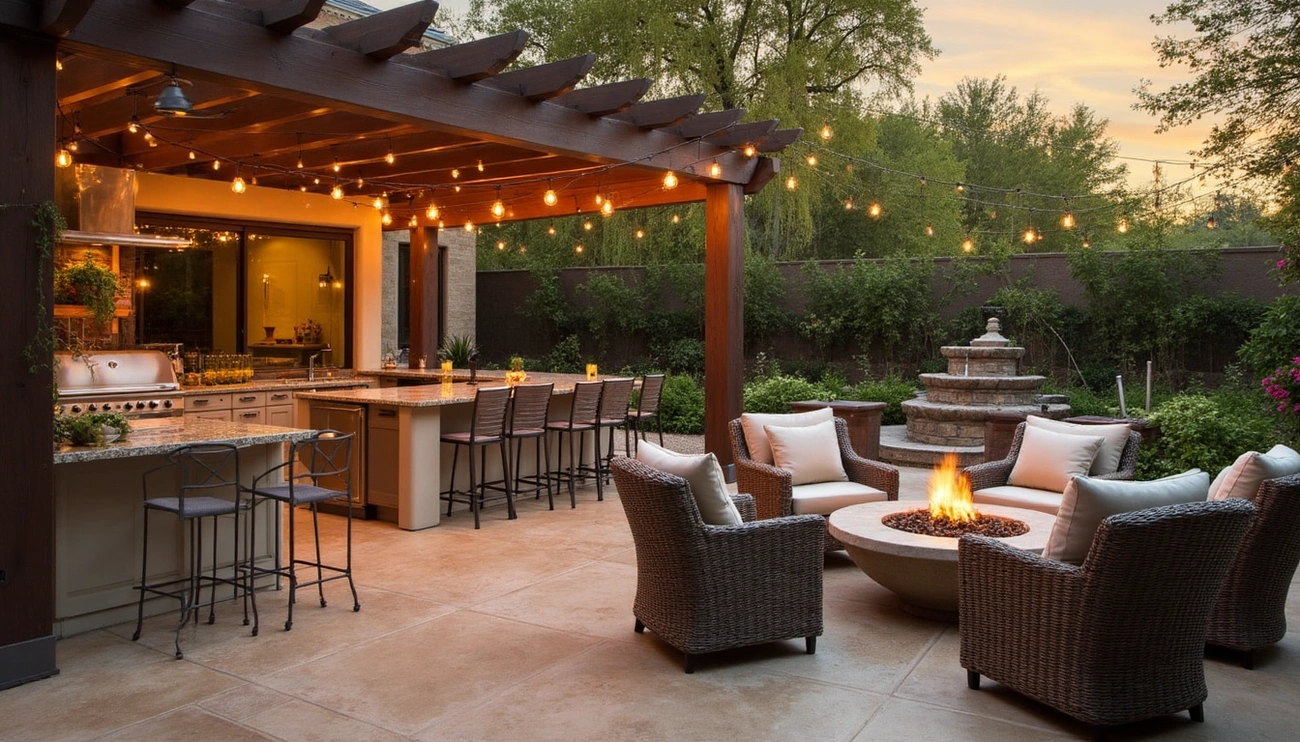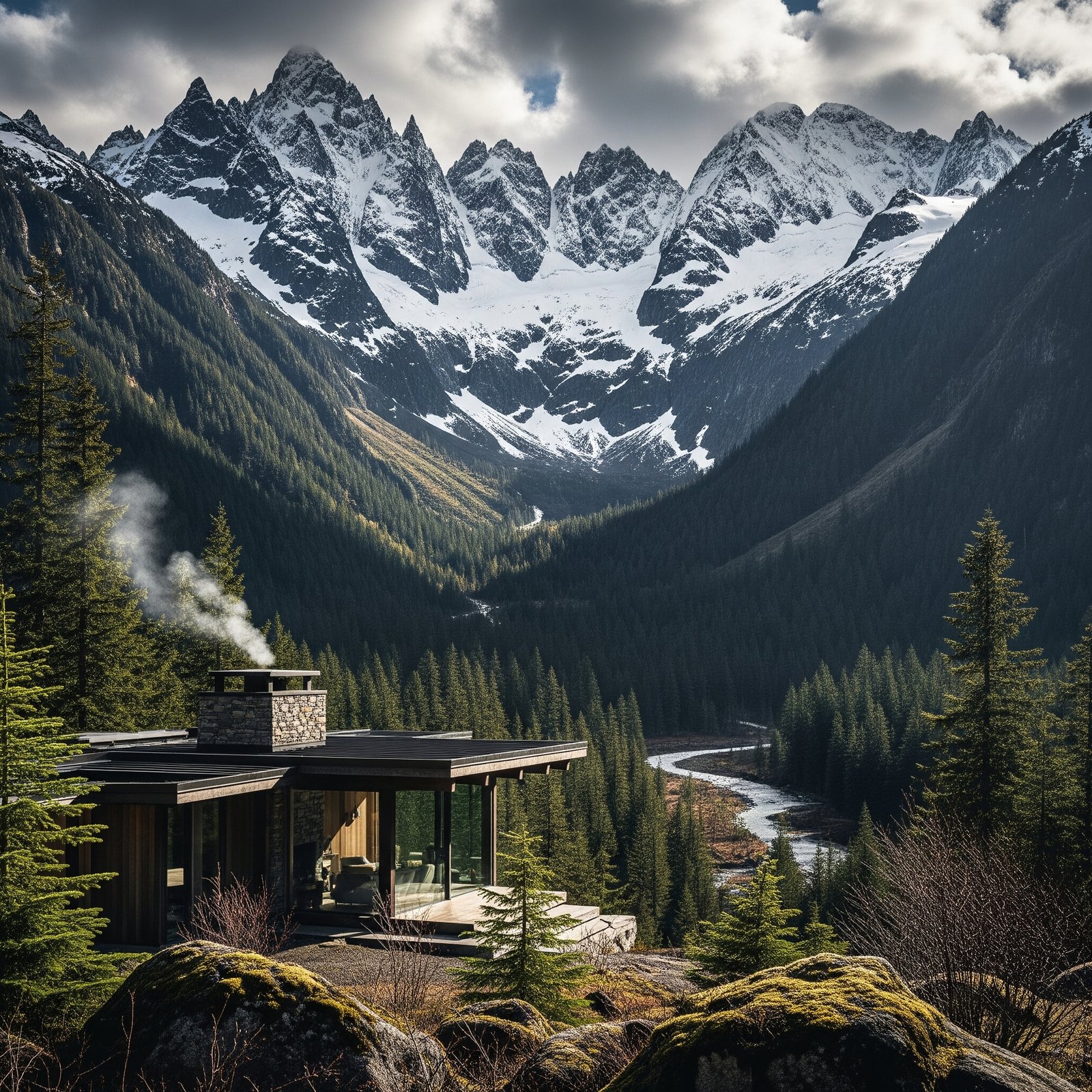A backyard patio gives homeowners a relaxed atmosphere to spend time with family and friends while adding value to their property. Your well-designed outdoor space acts like an extra room in your home.
A misting system stands out as a practical addition that can cool patio temperatures by 15-20 degrees using just a few gallons of water per hour. You can create distinct outdoor “rooms” in your yard to describe spaces for specific activities, similar to your home’s interior. The best functional backyard patio designs start with your family’s vision for using the space. Whether you’re thinking over backyard covered patio ideas, installing a fire pit, or learning about lighting options, the goal stays clear – create a space that naturally extends your indoor living area.
Homeowners can change their ordinary backyards into extraordinary retreats this summer with the right features. Comfortable patio furniture arranged for conversation and eco-friendly water features that save resources are great additions. These seven must-have elements will help you build the perfect summer oasis.
Outdoor Kitchen or BBQ Island
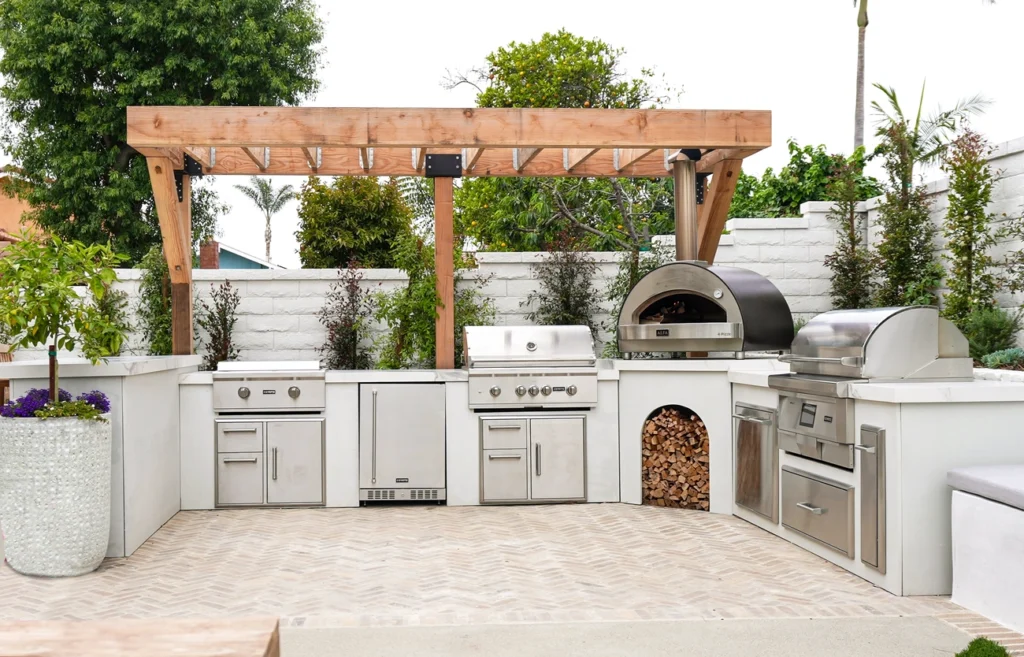
Image Source: RTA Outdoor Living
A well-designed outdoor cooking station can turn your back yard patio into an amazing entertainment hub. Modern outdoor kitchens go beyond basic grilling setups. They blend cooking functionality with stylish design elements that complement your patio’s overall look.
Outdoor kitchen features and layout
The best outdoor kitchens feature four distinct work zones: cooking, preparation, plate-and-serve, and entertainment. This design takes the traditional indoor kitchen “work triangle” and adapts it into a more practical outdoor “work square.” Your cooking flow and accessibility will improve.
The cooking zone stands as the centerpiece of most kitchen island layouts. You might want to include:
- Built-in grills (gas, charcoal, or smoker options)
- Side burners for additional cooking surface
- Pizza ovens for versatility
- Storage drawers for grilling tools
“Adequate counter space is crucial for food preparation and serving,” notes one landscaping expert. “It should be made of durable materials like granite or stone that can withstand outdoor conditions and frequent use”. Place the prep zone next to the cooking area. A sink here helps you avoid multiple trips indoors.
Your BBQ island layout options include:
- Linear islands: Perfect for budget-conscious buyers and small spaces. The grill sits in the middle with components on each side
- Galley islands: Two parallel islands with space between work great when multiple cooks share the kitchen
- U-shaped islands: These offer extra space and create a natural gathering spot
Material choices matter. Granite, stone, marble, or stainless steel countertops resist weather and last longer. Marine-grade materials or specialized outdoor-rated products protect your cabinetry from moisture damage.
Why an outdoor kitchen is a summer essential
Your outdoor kitchen adds an entire room without traditional construction costs. It creates the perfect spot to socialize. Hosts can chat with guests instead of being stuck indoors.
The practical benefits make sense too. Summer cooking stays outside, which cuts your AC costs. Strong food smells stay outdoors instead of lingering in your home.
“Outdoor kitchens bring the comforts of home outdoors, building a backyard retreat for cooking, relaxing, and entertaining,” according to BBQ Guys. This extra living space becomes invaluable during summer months when families want to spend time outside.
The numbers support this investment. Outdoor space improvements rank high for return on investment—something you’ll enjoy before selling. Experts estimate well-designed outdoor kitchens return 100-200% of their cost.
These installations create natural gathering spaces that are worth the investment. You get refrigeration for drinks, plenty of counter space for serving, and built-in seating areas. Some homeowners add outdoor sound systems or TVs to boost the experience.
Outdoor kitchen pricing and installation tips
Outdoor kitchen costs vary based on size, materials, and features. The 2025 data shows average costs from USD 5060.00 to USD 17280.00. Most homeowners spend about USD 13180.00.
Size affects your budget:
- Kitchenettes (under 100 square feet): USD 3200.00 to USD 10000.00
- Small kitchens (100-200 square feet): USD 3200.00 to USD 30000.00
- Medium kitchens (200-400 square feet): USD 8000.00 to USD 50000.00
- Large kitchens (over 400 square feet): USD 16000.00+
Your kitchen’s location affects installation costs. “Perimeter” kitchens near the house can use existing gas, water, and electrical lines. This costs less than “satellite” kitchens built far from your home.
Here are some budget-friendly strategies:
Start with outdoor kitchen kits or prefabricated islands. They cost USD 250.00 to USD 475.00 per linear foot versus USD 320.00 to USD 670.00 for custom builds. These come partially assembled and save on materials and labor.
Build on existing patios to skip extra landscaping costs. Put appliances near utility lines to reduce plumbing and electrical work.
Look at imported products as alternatives to premium domestic brands. “You can get really good quality at a lower cost if you are willing to consider imported products,” says Erin Hopson, an outdoor kitchen design team lead.
Professional installation makes sense. Contractor rates run USD 300.00 to USD 500.00 daily, with total labor between USD 3300.00 and USD 6400.00. Electrical work adds USD 350.00 to USD 2000.00 for proper wiring.
Most professionals finish construction in four to six weeks. This covers framing, flooring, utilities, and appliance installation. Site prep, special orders, or seasonal availability might extend this timeline.
Protect your investment in colder climates. Turn off the grill’s gas, unplug appliances, drain water lines, and seal cabinets before winter.
A well-planned outdoor kitchen becomes your back yard patio’s centerpiece. It boosts your enjoyment and property value for years ahead.
Fire Pit or Outdoor Fireplace
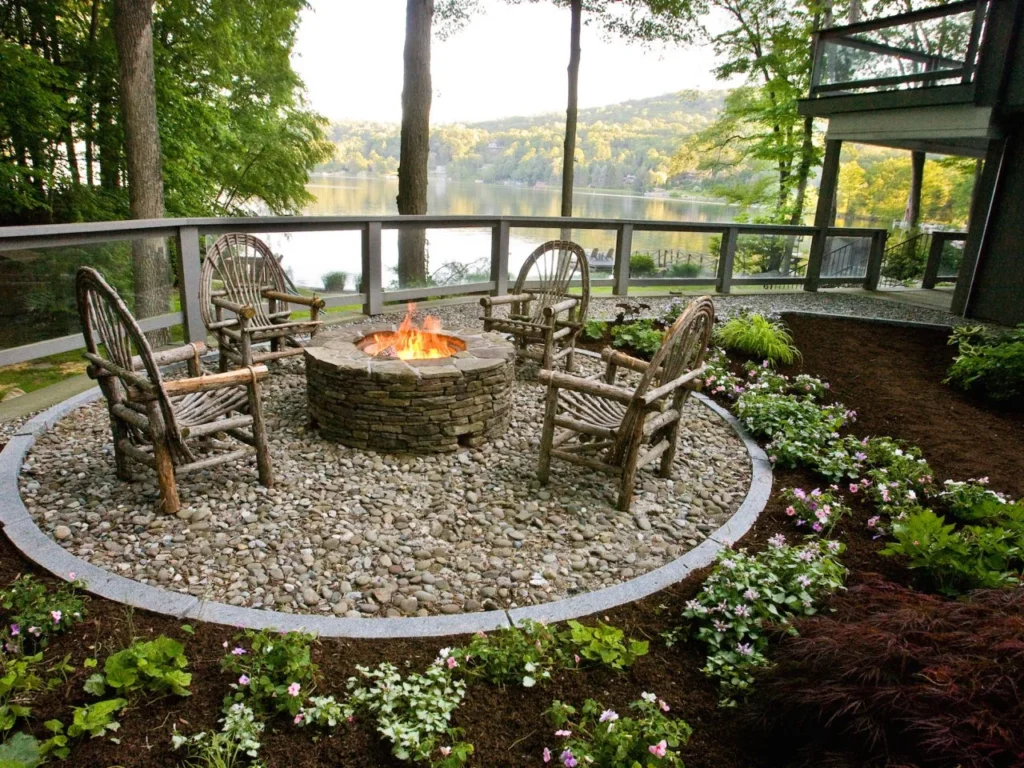
Image Source: HGTV
A fire feature makes the perfect centerpiece for any backyard patio. It creates a welcoming spot for gatherings that continue long after sunset. A well-designed fire pit or outdoor fireplace will let you enjoy your patio through multiple seasons and naturally becomes the heart of your outdoor space.
Types of back yard patio fire pits
Fire pits come in many designs, and each works best in different backyard settings. Knowing these options helps you pick the right one for your needs.
Wood-burning fire pits give you that authentic campfire experience many homeowners love. These classic options deliver excellent heat and come with those nostalgic crackling sounds and aromatic wood smoke. They cost less to start with, but wood-burning units need regular upkeep, including ash cleanup and a place to store firewood.
Gas fire pits (both natural gas and propane) make life easy with push-button ignition and flame control. Natural gas versions link to your home’s gas line, so you’ll always have fuel without refills. Propane models let you move them around but need new tanks now and then. Both give you clean burns without smoke or ash, though they cost more upfront than wood options.
Alternative fuel options include:
- Gel fuel fire pits – These work great in smaller spaces with no smoke or smell
- Ethanol fire pits – Earth-friendly with renewable fuel sources
- Electric fire pits – The safest choice with zero emissions, perfect for city living
People who want something more substantial might prefer outdoor fireplaces as dramatic focal points. “If you’re looking for a more modern and convenient look, gas fire tables are a great option,” notes one industry expert. These designs merge naturally with modern backyard furniture and double as table space when not lit.
Fire pit safety and placement
Safety should guide where you put your fire pit. Most guidelines say to keep fire pits at least 10 feet from structures like your house, sheds, fences, and trees. This helps prevent heat damage to nearby surfaces and keeps sparks from causing problems.
“Fire pits should be placed on a stable, even, fire-resistant surface,” advises the Travelers insurance company. Concrete, stone, or brick patios work well, while wooden decks need special fireproof bases. You should also check what’s above – never put fire pits under string lights, power lines, or low branches.
Wind direction matters a lot in placement. Your fire pit should sit where widespread winds blow smoke away from seats and your house. “If a light breeze is blowing, advise guests to sit on the upwind side of the pit to keep clear of the smoke,” suggests survival expert Hugh Simpson.
Key safety practices include:
- Keep fires attended at all times
- Make sure kids and pets stay 3-10 feet from flames
- Have water, sand, or a fire extinguisher ready
- Skip using it during high winds or drought
- Put fires out completely before leaving
Fire pit pricing and fuel options
Prices vary substantially based on type, materials, and features. Wood-burning fire pits cost less upfront but might cost more over time as you buy fuel. Gas options need more money at first but often cost less to run, especially natural gas models.
Here’s what to think over with fuel options:
Wood: Gives you that real experience with good heat but needs regular care. Hardwoods like oak burn longer than softwoods but usually cost more. Wood makes the most smoke and needs storage space.
Propane: Makes things easy with adjustable flames and no cleanup, though tanks need refills. A tank lasts 8-20 hours depending on flame size, making it reasonably priced for occasional use.
Natural Gas: Links to your home’s gas line for endless fuel without refills. Installation costs more to start, but this option ends up most economical for frequent users. You’ll need professional installation.
Gel Fuel: Burns clean without smoke or smell but doesn’t give much heat. These portable options are great for small gatherings, though canisters last only 2-6 hours, making them pricey for regular use.
Your choice between fire pit styles and fuel types depends on your backyard design goals, how often you’ll use it, and how much maintenance you want to do. All the same, whatever option you pick, a well-designed fire feature naturally becomes everyone’s favorite gathering spot in your outdoor space.
Comfortable Back Yard Patio Furniture
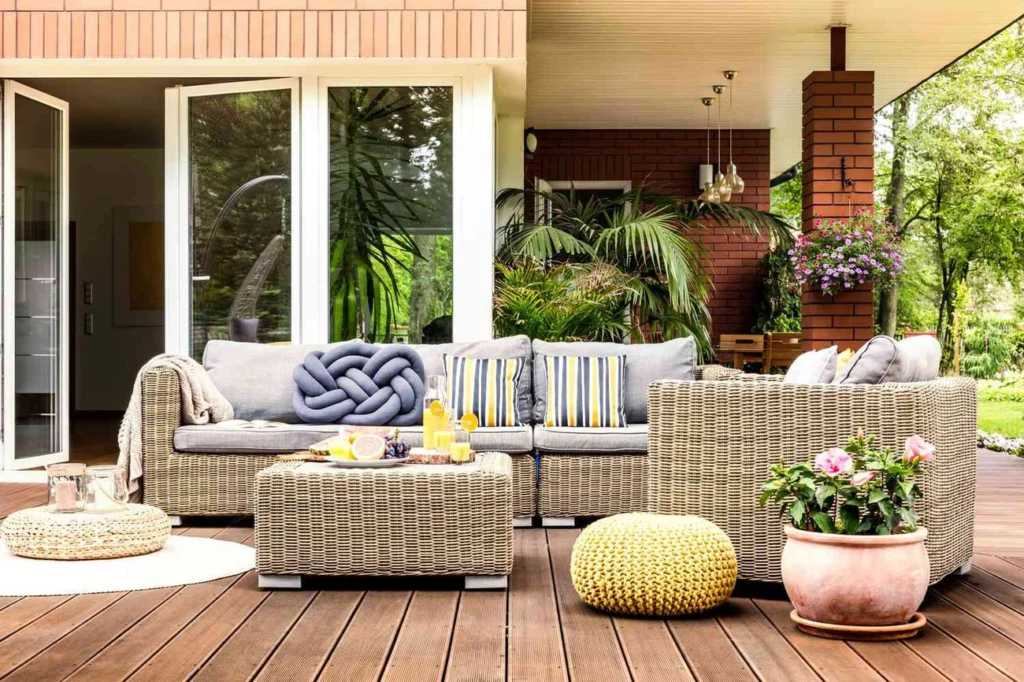
Image Source: Martha Stewart
Picking the right back yard patio furniture is a vital investment that creates a comfortable outdoor retreat. Your furniture choices will affect how often and comfortably you’ll enjoy your outdoor space during summer.
Best materials for desert and summer climates
Hot desert climates and intense sun exposure mean you’ll need to pick your furniture materials carefully. Cast aluminum works great because it doesn’t get as hot as other metals and stays cooler even in direct sunlight. This material lasts long and resists rust and corrosion, making it perfect for places that get occasional rain followed by bright sun.
“Aluminum doesn’t absorb heat like other metals, so it stays cooler to the touch than other metals, even in direct sunlight,” notes one furniture expert. It’s worth mentioning that any material left in direct sunlight will heat up eventually.
Synthetic resin wicker stands out as another excellent choice for hot climates. Unlike natural wicker, manufacturers design synthetic wicker to handle UV exposure without losing color or breaking down. “Synthetic resin wicker is engineered to be resistant to UV rays and moisture,” which makes it especially useful in desert areas where sun damage quickly ruins lower-quality materials.
Teak wood performs exceptionally well in hot climates for those who love natural materials. Its natural oils protect against moisture and insects without constant upkeep. “Teak is naturally resistant to heat, sunlight, and humidity, making it one of our favorite patio furniture materials for hot climates,” confirms one industry source.
High-density polyethylene (HDPE) might be the most heat-resistant option you can find. Made from recycled materials like milk jugs, quality HDPE furniture has UV inhibitors that keep colors from fading. Many manufacturers back these products with impressive 20+ year warranties, showing how well they hold up in tough conditions.
Back yard patio furniture styles and trends
Back yard furniture trends in 2025 focus on natural and organic materials that blend with outdoor spaces. Rattan, wicker, and teak lead the pack with their good looks and durability.
Modern patio furniture has shifted away from subtle colors. “Gone are the muted tones of past years; it is time for bold, expressive designs that bring energy to outdoor spaces,” notes one design expert. You can add bright cushions with jewel tones or geometric patterns to update your patio without buying new furniture.
Modular furniture sets are popular now because they’re so flexible. You can arrange these pieces in countless ways – from large gatherings around fire pits to cozy conversation spots. “These pieces quickly adapt to suit various needs… allowing for endless configurations that can change with the seasons or the occasion,” which makes them smart investments.
Indoor and outdoor furniture styles keep mixing, with pieces that look great in both settings. This flexibility adds value since some pieces can move inside during winter.
Furniture pricing and maintenance tips
Different materials need different levels of care. One expert says, “Routine cleaning is key. Use a soft-bristled brush to sweep away dirt and debris regularly”. Warm water and mild dish soap work well for deep cleaning most materials.
Furniture covers are one of the best ways to make your furniture last longer. “Unless you are outdoors consistently each day, I recommend using furniture covers when items are not in use,” suggests cleaning expert Rosa Picosa. These covers protect against harsh weather and sun that can fade fabrics quickly.
If you live where winters get rough, factor in storage options before buying. “If you live in a place with harsh winters, save your outdoor furniture from the elements by storing it somewhere safe, covered, and warm until summer comes again,” recommends one expert. Stackable chairs and folding pieces help when garage or shed space runs tight.
Choose your fabrics carefully, especially for cushions and pillows. Look for performance fabrics that fight mold and moisture in humid weather. “One thing I look for in performance fabrics is antimicrobial properties,” notes HGTV Dream Home designer Brian Patrick Flynn.
Your back yard furniture should match how you plan to use your outdoor space. One expert suggests, “Consider all the ways you and your family use your patio when choosing the furniture that best meets your needs”. Comfortable seating arranged for conversation works best for entertaining, while dining tables become must-haves if you eat outside often.
Back Yard Patio Lighting Ideas

Image Source: Outdoor Solar Store
The right lighting lets you enjoy your back yard patio after dark. It creates a welcoming atmosphere and makes the space safer. Good lighting choices can turn basic outdoor areas into magical nighttime spots where family and friends want to stay longer.
Types of lighting for ambiance and safety
Outdoor lights serve three different purposes. Task lighting helps you see walkways, steps, and cooking areas better to prevent accidents. Ambient lighting sets the mood, while accent lighting makes architectural features or landscaping stand out.
Your back yard patio can become magical with these popular lighting choices:
- String lights (also called fairy or twinkle lights) add charm when you drape them across patios, wrap them around trees, or hang them on railings. Edison bulb string lights show off their filaments and light up dining and conversation areas.
- Lanterns built from weather-resistant materials look elegant and work anywhere. You can group them on tables, place them around patio edges, or hang them from posts to create cozy spots for evening gatherings.
- Path lights keep walking safe and make landscaping look better. “Use solar lights that turn on at dusk to highlight your lush greenery or blooms to enhance the natural beauty surrounding your home,” suggests one landscape designer.
- Wall-mounted fixtures like sconces and lanterns light up spaces and boost your home’s appeal. These work best on covered patios and blend indoor and outdoor areas.
Each type of outdoor light adds something special to your design. Low-voltage path lighting gives off soft light without glare – perfect for walkways. Spotlights aimed at trees or water features catch the eye and add height to your space.
Solar vs. electric lighting options
You’ll need to balance convenience and performance when choosing between solar and electric lights. Solar lights use the sun’s energy during the day to power up for night. These units work on their own without wiring – just put them where they get enough sun.
“Go for solar lights. This lighting option is very user-friendly as most of them charge during the day from sunlight and light up on their own at night,” notes one landscaping expert. Solar options help the environment by using less energy.
All the same, electric (wired) lighting has clear benefits. These lights stay bright no matter what the weather’s like. Unlike solar lights that might dim after cloudy days, wired lights keep shining until you turn them off. Electric systems also give you more control with:
- Timers for automatic scheduling
- Dimmers for mood adjustment
- Smart controls for remote operation
- Motion sensors for security enhancement
So your choice depends on what you need most. Solar lights shine in sunny spots where easy setup matters more than steady brightness. Electric lighting makes sense when you want consistent light and control features.
Lighting placement and design inspiration
Smart placement turns basic lighting into amazing ambiance. Beyond lighting paths, think about how lights can show off your back yard patio’s best parts.
String lights create magic overhead. “String festoon lights across your pergola or arbor for a whimsical feel. Go for a single long line or criss-cross pattern,” suggests one design expert. Use a strong guide wire between supports instead of letting the light cord hold weight.
Water features look dramatic with the right lighting. “Magnify the tranquility of your garden fountain or waterfall with lights,” recommends one designer. Water reflects light and creates amazing patterns that turn simple features into showstoppers.
Light sources at different heights add depth to your space. Mix low pathway lights, mid-level accent lights, and overhead string lights. This approach stops harsh shadows and lights up your whole back yard patio.
LED options save energy and money. “LED bulbs consume less power and last longer than traditional bulbs,” notes one expert. Most landscape lights now use LED technology, giving bright light while keeping energy costs down compared to old-style bulbs.
Shade Structures and Covered Patio Ideas
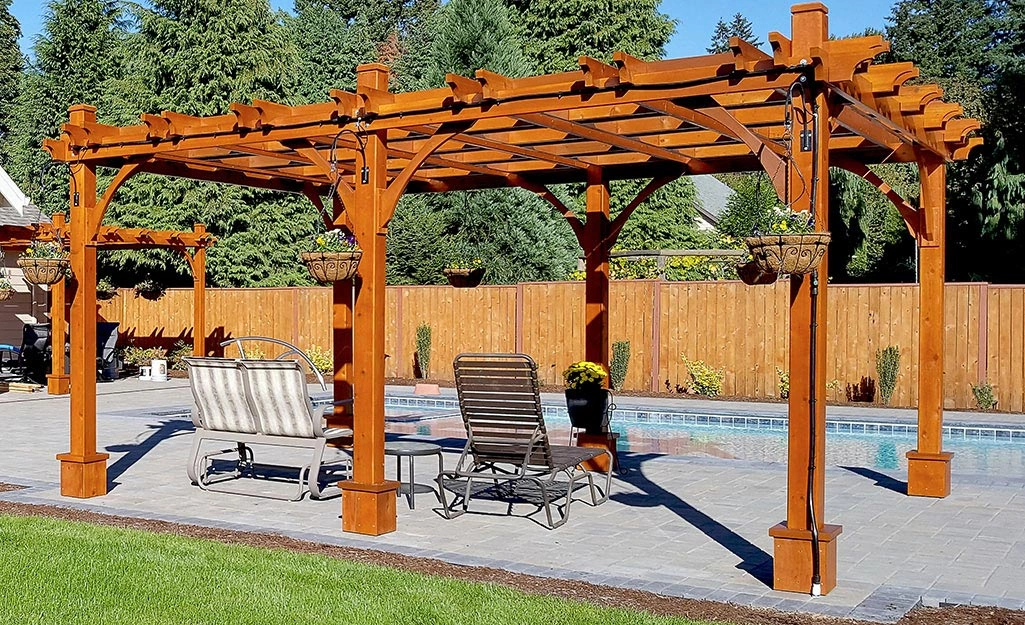
Image Source: The Home Depot
Shade structures can turn basic backyard patios into living spaces you can enjoy whatever the weather. A shield from harsh sunlight makes outdoor spaces more comfortable and creates defined outdoor “rooms.” These spaces blend indoor comforts with a relaxed outdoor feel.
Popular backyard covered patio ideas
Covered patios blend indoor and outdoor spaces naturally. They add extra square footage perfect for entertaining. A well-laid-out covered patio works for multiple uses. You can set up dining areas with farm tables and woven chairs or create cozy spots with sectional seating.
Materials range from corrugated aluminum to wood slat roofs. Natural texture and durability come from teak walls paired with bluestone floors. Louvered panels let you adjust sun protection as seasons change.
Yes, it is true that well-designed covered patios help unite your home’s landscaping and architectural features. Curved lines and traditional details work well with formal gardens. Modern designs look great with contemporary homes.
Pergolas, umbrellas, and retractable awnings
Pergolas rank among the most flexible shade options. They define spaces while letting filtered light through. These structures are the perfect support for fragrant climbing plants like wisteria, roses, and jasmine. The plants add natural beauty and extra shade.
Modern functionality comes in several forms:
- Motorized louvered pergolas – Slats close to create waterproof cover or open to catch morning sun with just one button push
- Retractable awnings – Wall-mounted options extend or pull back when needed to protect indoor and outdoor areas
- Patio umbrellas – Many styles are available including center-of-table models, cantilever designs, and tilting versions for adjustable coverage
“The best shade solutions blend functionality with resort-worthy style,” notes one industry expert.
Economical shade solutions
Shade options are available to fit any backyard patio budget. Shade sails cool large or oddly shaped areas economically. These come in triangular or rectangular shapes. You can overlap fabric swaths to protect patios and pools.
Pop-up canopies give temporary protection from sun and rain. They work perfectly for renters or occasional use. Quality canopies start at USD 239.00.
Planting shade trees offers the most economical long-term solution. Trees placed strategically can drop temperatures by up to 20°F in hot weather. This approach mixes beauty with function and boosts property value.
DIY fans can create simple projects. Adding shade cloth over existing pergolas gives UV protection for about USD 175.00.
Water Features for Relaxation

Image Source: Aquascape
Water features bring something special to backyard patios that other elements can’t match. The soft sounds of flowing water create a peaceful atmosphere that turns ordinary outdoor spaces into peaceful retreats.
Types of water features: fountains, ponds, waterfalls
Fountains are the most available water feature option, and they come in many styles that match any backyard patio design. Bubbling boulders create a geyser effect as water flows down multiple sides of naturally cored stone. Tiered fountains become dramatic focal points in Mediterranean-style spaces, while tabletop versions fit perfectly in smaller areas.
Ponds add living elements to your outdoor space. Koi ponds, also called water gardens, need minimal maintenance if you design them as self-sustaining ecosystems. Reflecting pools make spaces look larger through mirroring effects, which makes them perfect for smaller gardens.
Pondless waterfalls give you the visual and sound benefits of traditional waterfalls without standing water concerns. These features use hidden reservoirs beneath decorative gravel that eliminate algae growth and mosquito breeding grounds.
Benefits of adding water elements
We added water features to create calming environments. The sound of flowing water helps reduce stress, lowers anxiety, and brings tranquility. This natural sound barrier blocks unwanted neighborhood noise and creates a more private atmosphere.
Beyond mental benefits, water features attract wildlife and enhance biodiversity in your backyard patio space. Birds, butterflies, and beneficial insects visit often, which provides entertainment and learning opportunities.
Water features improve surrounding air quality by releasing negative ions that reduce potential toxins. The evaporation process creates a cooling effect that makes your patio more comfortable during hot summer months.
Eco-friendly and low-maintenance options
Modern water features need minimal upkeep. Self-contained, recirculating systems don’t need constant water replenishment. Closed-loop designs work up to 50% more efficiently than traditional systems.
Solar-powered options utilize sunlight to run pumps and lighting elements without increasing energy bills. These systems run during daylight hours and work automatically at night.
Bubbling boulders and pondless waterfalls need only periodic pump cleaning and debris removal. Most installations require just one major cleaning each year, which lets you enjoy them more with less work.
Misting Systems for Cooling Comfort
Misting systems are a great way to get innovative cooling on hot summer days. They can turn a sweltering back yard patio into a comfortable retreat through scientific principles instead of expensive air conditioning.
How misting systems work
The technology employs evaporative cooling principles. High-pressure systems turn water into microscopic droplets (typically 5-30 microns or 0.005-0.03 mm) that evaporate instantly in the air. This evaporation absorbs heat from surrounding air molecules and creates a cooling effect. The system’s three main components include a pump unit that pressurizes water to 60-100 bar (870-1450 psi), pressure-resistant tubing, and specialized misting nozzles with tiny orifice diameters between 0.15-0.3 mm.
Benefits in hot climates
These systems can lower ambient temperatures by up to 20°F in optimal conditions. The cooling works best in dry, hot environments with temperatures above 77°F and relative humidity below 60%. The systems help trap dust particles and other air pollutants, which filters them from the air. This technology saves more energy than traditional air conditioning and produces no harmful emissions.
Installation and water usage
The right placement makes all the difference. The mounting height should be 8-10 feet so mist evaporates before reaching surfaces. Nozzles work best when spaced 2-4 feet apart. You’ll need to place the pump near both a water source and electrical outlet. Then run tubing along the patio’s perimeter with strategically positioned nozzles.
These systems use water efficiently. A system with twenty 0.2mm nozzles needs about 60 liters (16 gallons) per hour. You can expect annual costs between USD 30.00 and USD 100.00. Fine droplets combined with timer controls make these systems more water-efficient than traditional cooling methods.
The best part? Your family can enjoy the back yard patio even on the hottest summer days. These systems create comfortable environments that extend your outdoor living space throughout the season.
Conclusion
Creating Your Personal Outdoor Paradise
Seven must-have back yard patio features can reshape the scene and turn ordinary outdoor spaces into amazing retreats. You can choose to add all these elements or pick the ones that fit your climate and lifestyle best. Each addition will improve your patio’s usefulness and enjoyment by a lot.
Fire features are natural gathering spots that let you use your space late into the evening and during cool weather. Well-placed, cozy furniture creates perfect spots for conversations and encourages everyone to stay longer. Good lighting makes the space come alive at night and keeps everyone safe.
Shade structures help you stay comfortable during the day and double your usable hours in hot summers. Water features add peaceful sounds that block out neighborhood noise. An outdoor kitchen saves you from running back and forth to the house. You can stay with your guests instead of being stuck inside while cooking.
Misting systems work great in hot areas without wasting water or energy. These can cool the air by up to 20°F and make hot spaces much more pleasant.
Your back yard oasis should reflect your style. Think about how you’ll use your outdoor space most often and choose features that matter to you. Adding all seven elements creates an amazing retreat, but even two or three can turn a basic patio into something special.
A perfect summer hideaway adds more living space to your home and gives you a place to escape daily stress. With smart planning and the right features, your back yard can become the neighborhood’s favorite outdoor spot. It’s an investment that pays off in both property value and amazing memories made in your personal paradise.

